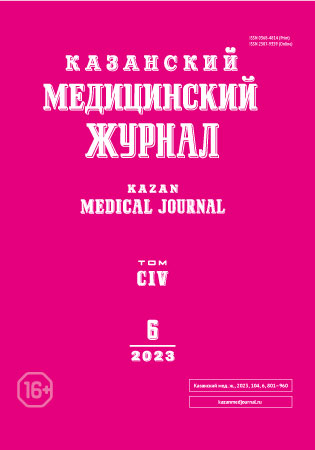Anatomical parameters for assessing the cervical spine in normal conditions and with Kimmerle anomaly according to spiral computed tomography data
- Authors: Chaplygina E.V.1, Kalashaov B.M.1, Kuchieva M.B.1
-
Affiliations:
- Rostov State Medical University
- Issue: Vol 104, No 6 (2023)
- Pages: 859-866
- Section: Theoretical and clinical medicine
- Submitted: 19.04.2023
- Accepted: 30.10.2023
- Published: 05.12.2023
- URL: https://kazanmedjournal.ru/kazanmedj/article/view/340835
- DOI: https://doi.org/10.17816/KMJ340835
- ID: 340835
Cite item
Abstract
Background. Spiral computed tomography makes it possible to visualize in detail the anatomical structures of the spinal column and thereby makes it possible to create a regulatory framework for the subsequent assessment of the results of this research method.
Aim. To determine the anatomical parameters for assessing the cervical spine in normal conditions and with Kimmerle’s anomaly according to spiral computed tomography.
Material and methods. Spiral computed tomograms (in DICOM format) of the cervical spine of people aged 21 to 70 years of both sexes who do not have pathology of the cervical spine (n=54), as well as with Kimmerle anomaly (n=36), were studied. The width, height and length of the cervical vertebral bodies were analyzed, the longitudinal and transverse diameters of the atlas, the thickness of the anterior arch of the atlas were measured, the transverse-longitudinal index of the atlas, and the ratio of the width of the arch to the transverse diameter of the atlas were calculated. The parameters of the vaulted foramen were measured: the vertical and anteroposterior dimensions of the vaulted foramen and the thickness of the bone bridge. Processing of statistical material was carried out using the application package Excel and Statistica 10.0. To assess the normality of data distribution, the Kolmogorov–Smirnov test was used. The reliability of differences in the average values of independent samples was assessed using the nonparametric Mann–Whitney test in case of non-normal distribution of the initial data. Changes were considered significant at p <0.05.
Results. In those examined without pathology of the cervical spine and with Kimmerle's anomaly, the vertebral body height indicators were characterized by a decrease from CII to CIII, with a subsequent increase from CIII to CVII; the vertebral body width and length indicators increased from CII to CVII. According to spiral computed tomography data, in examined patients with Kimmerle anomaly, the average values [M (SD)] of the width of the posterior arch of the atlas on the right [8.8 (2.0) mm] and on the left [9.1 (1.7) mm], the ratio of the posterior arch to the transverse diameter of the atlas on the right [11.2 (2.6)%] and on the left [11.8 (2.2)%] was significantly (p <0.05) higher than similar sizes [7.5 (1.5) mm; 7.5 (1.1) mm; 9.6 (1.8)%; 9.6 (1.4)%, respectively] in people who did not have pathology of the cervical spine.
Conclusion. In patients with Kimmerle's anomaly, compared with the norm, there are differences in the width of the arch of the atlas, the ratio of the posterior arch to the transverse diameter of the atlas on the right and left.
Full Text
About the authors
Elena V. Chaplygina
Rostov State Medical University
Email: ev.chaplygina@yandex.ru
ORCID iD: 0000-0002-2855-4203
SPIN-code: 2050-1234
M.D., D. Sci. (Med.), Prof., Head of Depart., Depart. of Normal Anatomy
Russian Federation, Rostov-on-Don, RussiaBaizet M. Kalashaov
Rostov State Medical University
Author for correspondence.
Email: kalachaov@yandex.ru
ORCID iD: 0000-0002-6030-6496
PhD Stud., Depart. of Normal Anatomy
Russian Federation, Rostov-on-Don, RussiaMargarita B. Kuchieva
Rostov State Medical University
Email: ritaku@mail.ru
ORCID iD: 0000-0001-6890-7205
M.D., Cand. Sci. (Med.), Assoc. Prof., Depart. of Normal Anatomy
Russian Federation, Rostov-on-Don, RussiaReferences
- Westermann L, Spemes C, Eysel P. Computer tomography-based morphometric analysis of the cervical spine pedicles C3–C7. Acta Neurochir. 2018;160:863–871. doi: 10.1007/s00701-018-3481-4.
- Salakhbekov IS, Tvardovskaya MV. Variants of the structure of some bone structures of the occipito-atlantoaxial complex. Russian military medical academy reports. 2020;39(S1–2):150–152. (In Russ.) doi: 10.17816/rmmar43409.
- Gafiatullin MR, Zhabinsky VD, Yatsenko EV. Anomaly of Kimmerle Forcipe. 2021;4(S1):130. (In Russ.)
- Kulagin VN, Mikhailyukova SS, Lantukh AV, Balaba YaV, Matochkina AS, Popova AA. Kimmerle anomaly: aspects of diagnosis and treatment of major clinical syndromes. Pacific Medical Journal. 2013;(4):84–87. (In Russ.)
- Alekseeva NT, Karandeeva AM, Kvarachelia AG, Anokhina ZhA, Serezhenko NP. Types of ossification of posterior occipital membrane (Kimmerle anomaly). Journal of anatomy and histopathology. 2013;2(3):55–57. (In Russ.)
- Komyakhov AV, Klocheva EG, Mitrofanov NA. Cerebral hemodynamics in patients with Kimmerle anomaly. Belgorod State University scientific bulletin. Medicine, pharmacy. 2011;(4-1):112–116. (In Russ.)
- Yanova EU, Yuldashev AR, Giyasova NK. Kimmerle's anomaly during visualization of the craniovertebral region. Vestnik of KSMA named after IK Akhunbaev. 2021;(4):130–134. (In Russ.)
- Chaplygina EV, Kaplunova OA, Dombrovsky VI, Sukhanova OP, Blinov IM, Fishman AYu, Mukanyan SS. Morpho-functional characteristics of Kimmerle ano-maly. Morphology. 2015;147(3):27–31. (In Russ.)
- Gulyaev SA, Kulagin VN, Arkhipenko IV, Gulyaev СЕ. Clinical manifestations of craniovertebral region abnormalities according to the Kimmerle variant and the features of their treatment. Russkiy meditsinskiy zhurnal. 2013;(16):866–868. (In Russ.)
- Chaplygina EV, Kuchieva MB, Kalashov BM. Anatomical variability of the cervical spine in age, sex and type aspects. Possibilities and prospects of studying. Modern problems of science and education. 2021;(3):178. (In Russ.) doi: 10.17513/SPNO.30791.
- Babayev MV, Harlamov EV, Khoronko VV. The comparative analysis of rentgenogrammetric parameters of chest department of a columna vertebralis in norm and at an osteochondrosis depending on somatotype. Medical herald of the South of Russia. 2010;(1):54–57. (In Russ.)
- Alekseev VP. Osteometriya: metodika antropologicheskikh issledovaniy. (Osteometry: methodology of anthropological research.) M.: Nauka; 1966. 251 р. (In Russ.)
- Anisimova EA, Anisimov DI, Popryga DV, Yakovlev NM, Zhurkin KI. Patterns of variability in the size and shape of the cervical spine. Morphology. 2011;140(S4):67. (In Russ.)
- Schikunova NA, Varysina TN, Klimenko LN. Variants of Kimmerle anomaly. Morphology. 2014;145(3):230. (In Russ.)
Supplementary files









